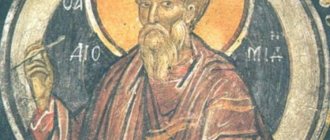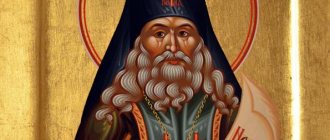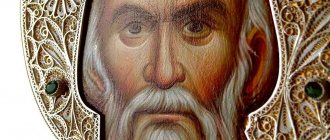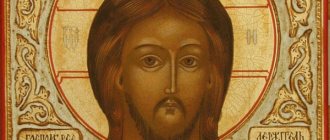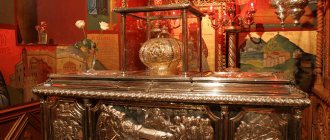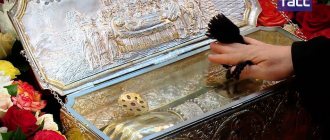This term has other meanings, see Vit (meanings).
| Vit | |
| Vitus | |
| Master Theodoric, "St. Vitus" | |
| Was born | 290 Mazara |
| Died | 303(0303) Rome |
| In the face | martyrs |
| Day of Remembrance | in the Orthodox Church on May 16 and June 15 (according to the Julian calendar), in the Catholic Church on June 15 |
| Patron | boilermakers, actors |
| Media files on Wikimedia Commons | |
Martyrdom of Saints Vitus, Modestus and Crescentia, French manuscript, 14th century
Saint Vitus
(lat. Sanctus Vitus) - Christian saint, Roman martyr of the period of early Christianity. He was killed in 303. The memory of Saint Vitus is celebrated in the Orthodox Church on May 16 (29) and June 15 (28), in the Catholic Church on June 15[1].
Biography[ | ]
Reliable historical evidence about the life and martyrdom of St. Vitus has not survived. According to church tradition, St. Vitus was a boy of seven (according to other sources, twelve) years old, the son of a pagan Roman senator from Sicily. The boy converted to Christianity under the influence of his mentor. He was killed during the persecution of Christians by the Roman emperors Diocletian and Maximian.
According to legend, he went to Rome, where he cast out demons from the son of Emperor Diocletian. But when Vitus refused to pray to the Roman gods, he was arrested again and thrown to the lions, who did not touch the righteous man. Then Vitus was thrown into a cauldron of boiling oil.
Huntington's disease - a choreic dance on the bones of medicine
Huntington's chorea (second name) is a hereditary type of disease that most often manifests itself at the age of 25-50 years; cases of earlier development of the disease are quite rare. Males are much more likely to be affected by the disease.
The disease is characterized not only by the appearance of involuntary movements, but also by a significant decrease in intelligence, up to the complete loss of personality.
The disease develops gradually; as a rule, it is quite difficult to detect the appearance of the first involuntary movements. In most cases, they appear in the face area and look like motor automatisms that are familiar to everyone, for example, licking lips, opening the mouth, sticking out the tip of the tongue.
During the development of the disease, involuntary movements may occur in the arms (periodic twitching of the fingers) and torso; in the latter case, serious changes in gait and general statics are observed. Further, worse - it becomes difficult for a person to speak, swallow and chew, he loses memory and cannot remember such basic things as breathing correctly, smiling, holding a fork or spoon in his hand.
Provoking factors
Since Huntington's disease is hereditary, the main cause of its occurrence is genetic pathology.
The dynamic type of gene mutation provokes problems in the normal folding of the protein and the acquisition of toxic features. As a result, this protein accumulates in individual cells, which subsequently die.
The disease is transmitted through an autosomal dominant pathway, that is, from a sick parent to a child. In this case, it does not matter which parent is sick, the probability of transmitting the pathology is 50%.
It should be noted that transmission of the anomaly is possible only vertically, that is, from a sick parent to a child. If transmission of the disease has not occurred, then the child and his future children will already be healthy. The disease does not manifest itself after a generation.
Features of symptoms
The most striking symptoms of the disease are constantly increasing involuntary movements and grimaces on the face. A sick person is unable to exercise control over his physical activity. During speech, smacking may occur, the person begins to sniff his nose frequently, and slight swaying may be observed while walking.
The primary stages of the development of the disease are characterized by excessive excitability, slight forgetfulness, which intensifies as the disease progresses until it becomes a form of dementia.
Diagnostic criteria
Diagnosis of the disease is carried out on the basis of examination by a neurologist, symptoms and manifestations of this type of disease in parents.
During the examination, the neurologist examines the following parameters:
- hearing status;
- muscle strength;
- coordination while walking;
- reflexes;
- ability to maintain balance;
- the presence of uncontrolled movements.
In addition, the doctor analyzes the patient’s ability to follow the movement of an object with his eyes alone, this is due to the fact that in the presence of the above disease, this function is impaired.
In order to determine whether brain damage is present and what the severity of the disorders is, imaging methods are used, namely magnetic resonance imaging and computed tomography.
If the disease is present in one of the parents, then it is impossible to do without undergoing DNA diagnostics.
It is worth noting that at this stage of time there is also medical and genetic counseling, where professionals consider cases of disease manifestations in individuals, help them adapt to society, indicate the likelihood of having a sick child and methods that can reduce the risk of disease transmission.
At the same time, despite many modern methods of preliminary diagnosis, the only 100% option for not transmitting the disease to your children is their absence.
What does medicine offer?
Before starting treatment for the disease, you should definitely consult with an experienced neurologist. Self-medication in this case is fraught with rapid progression of pathology and final loss of personality.
It should be understood that it is not possible to completely recover from Huntington’s chorea, since the pathology lies directly in the genes. But you can slow down the development of the disease by taking a number of medications, the action of which is aimed at reducing the activity of the destructive process. These drugs include Haloperidol, Phenothiazine, Reserpine and others.
Unfortunately, once this pathology is identified, there is no favorable prognosis, since chorea cannot be completely cured.
But with timely detection of early symptoms and rapid initiation of treatment, it is possible to slow down the destructive process in nerve cells.
Literature[ | ]
- The Suffering of the Holy Martyrs Vitus, Modestus and Criscentia // Lives of the Saints in Russian, set out according to the guidance of the Chetyih-Menaias of St. Demetrius of Rostov: 12 books, 2 books. add. - M.: Moscow. Synod. typ., 1903-1916. — T. X: June, Day 15. — P. 341.
- Yovcheva M.
St. Vitus in ancient Slavic literature // Ancient Russia. Questions of medieval studies. — 2006. No. 4 (26). — P. 10—19. - Vitus, Modest and Criscentia // Orthodox Encyclopedia. - M.: Church-Scientific, 2004. - T. VIII: “Doctrine of Faith - Vladimir-Volyn Diocese.” — P. 574—576. — 752 p. — 39,000 copies. — ISBN 5-89572-014-5.
| Fourteen Holy Helpers | |
| |
Chorea
Lesser chorea is a toxic-infectious disease that occurs as a result of a rheumatic process. Most often occurs in children and young adults.
Characterized by the presence of the following manifestations:
- the child becomes awkward;
- changes in handwriting while writing;
- excessive fussiness;
- problems with speech clarity;
- insomnia;
- the appearance of involuntary movements is observed.
As the disease develops, involuntary movements become more frequent and noticeable, and the child’s mental balance is disrupted. With timely treatment, the development of pathological processes can be slowed down.
Despite the fact that St. Witte's dance is a symptom of incurable illnesses, you should not give up; modern medicine gives you a chance for a long life, albeit one that takes place in constant struggle.
Chorea. Changes in the functioning of the nervous system with chorea
The nervous system is the main regulator of all body activities. The spinal cord and brain ensure the coordinated functioning of skeletal muscles, internal organs, processing of information coming from outside and emotional response to the environment.
The ability to voluntarily control your body is one of the main components of a quality life. There are several levels of regulation of conscious movements. Skeletal muscles are controlled by nerve cells (neurons) located in the gray matter of the spinal cord. They, in turn, are completely subordinate to a special part of the brain - the cortex. It is here, in a small area of the cerebral convolutions, that nerve cells are present, which are the beginning of the path of voluntary movements.
The parts of the brain provide various aspects of the body's vital functions.
Most voluntary motor activity is a set of complex movements: walking, speaking, running, writing. Their clarity is ensured not by one cell, but by a group of different structures located in several parts of the brain. One of the centers for coordination of movements is located in the cerebellum. However, its neurons are entirely subordinate to a special part of the brain - the extrapyramidal system.
The central level of regulation of voluntary movements is located deep in the brain and consists of several anatomical structures - the basal ganglia. Each is an island of gray matter containing neurons connected to other parts of the brain. There are several similar clusters of neurons:
- pale globe;
- amygdala;
- caudate nucleus;
- shell and fence.
The basal ganglia are the main part of the extrapyramidal system
Normally, these nuclei are firmly interconnected with the cerebral cortex. The neural connections of these cells ensure the implementation of long-mastered voluntary movements - speech, walking, writing, in which many muscle groups are involved.
Chorea is a medical term denoting a neurological disease, which is based on damage to the nuclei of the extrapyramidal system of various natures. Both adults and children are susceptible to pathology. In some cases, the negative effects of chorea are reversible, in many cases they progress and inevitably lead to an unfavorable outcome.
The Mystery of St. Vitus's Dance. Epidemic of hysteria in medieval Europe.
Saint Vitus was considered the patron saint of those suffering from epilepsy and various forms of seizures, since such diseases were traditionally explained by the machinations of the devil or even his entry directly into the human body.
In Germany, in Desau, a crowd of local peasants, for no apparent reason, started dancing and went on a rampage until some of them fell down dead. Those who managed to survive then suffered convulsions and underwent an exorcism procedure (casting out a demon). This was recorded by the chronicler in 1021.
Then the famous “Utrecht Dance on the Bridge” took place in Holland. A crowd of dancers climbed onto the bridge spanning the Moselle River. The dancers' feet, stomping to the beat (although no one sang or played melodies, but everyone danced in agreement!) caused powerful resonant vibrations. The bridge collapsed, drowning and covering more than two hundred people with debris. This happened in 1237.
And here is the famous “Children’s Dance” of 1370. Many children, jumping and dancing, making gestures and nodding, passed through the entire Steigerveld. Having reached the city of Aryushtadt, the children fell down as if dead. Half of them died, the rest continued to dance all their lives, as soon as the “X” moment came. And no matter how much holy water was poured on them, nothing helped. In general, that year, throughout Europe at that time, especially in the German and Dutch lands, something unimaginable was happening. It’s as if the local ruler, like the well-known comrade Bunzha in the guise of Tsar Ivan Vasilyevich from the great comedy of Gaidai, shouted from the balcony of his palace: “Everybody dance!”
"St. Vitus." Master Theodoric. 14th century
In the middle of the second half of the fourteenth century, a strange madness gripped the inhabitants of many villages along the Rhine. Hundreds of respectable, neat Germans and German women came out of their houses and began to dance furiously. They jumped, squatted, spun, performing intricate dance steps with their feet, splashed their arms, spun and threw out knees to the envy of real acrobats. And they did all this without making a single sound. It seems that the music played only in the heads of the dancers. All around you could hear only the heavy, wheezing breathing of mortally tired people. Sometimes one of them fell. Sometimes someone who fell right here, on a place trampled underfoot, gave his soul to God. Exhausted people ate practically nothing and did not sleep, sometimes for a long time. And they continued to dance, dance, dance until their mutilated, worn out and trampled lower limbs, almost to the bone, broke under them.
Ilyinskaya Hospital
Special offers
Our dentists have special skills in psychological adaptation of children with negative experiences of dental treatment. Ilyinskaya Hospital page on FacebookIlyinskaya Hospital on InstagramIlyinskaya Hospital page on VKontakteIlyinskaya Hospital page on Odnoklassniki
And after a while this wonderful phenomenon suddenly stopped abruptly! It was as if someone had turned off the light or slammed the lid of a chest. The disease or witchcraft fog dissipated as quickly as it engulfed its victims. A special feature of this disease that year was the high tossing of legs and jumping, since those who did not die from a stroke or heart attack from the dance showed that they saw puddles and streams of blood under their feet, which they tried to jump over. In 1479-1480, an epidemic of furious, crazy dancing swept across Italy, which was christened after everyone’s favorite folk dance - the tarantella. The disease was called "tarantism". Film and football lovers, please do not confuse them with Tarantino and Tarantini.
Another such epidemic swept through the wonderful city of Strasbourg around 1518. A local lady, Frau Troffea, was suddenly seen dancing silently (except for puffing) on the cobblestones of the street. She danced furiously and danced, and nothing seemed to be able to stop her. Over the course of several days, she was joined by at least three dozen more dancing people, dancing, jumping, turning around, stamping their shoes, desperately and incomprehensibly gesticulating...
And, finally, a crowd of Parisians, stupefied from dancing, jumping and spinning right on the tombstones of the ancient Saint-Médor necropolis. The madmen moved with wild jerks and rolled their eyes on their trembling faces so that their dance could be mistaken for a zombie ballet. That is why this event went down in history as the “Convulsion Ball”.
Certified neurologists are well aware of Huntington's chorea, an exotic nervous disease that rarely affects humans. The disease is hereditary and therefore occurs very rarely in practice. Another thing is the phenomenon that for several centuries of the Middle Ages was called the dance of St. Witta. This strange insanity interested not only doctors and scientists, but also religious leaders, priests and inquisitor monks, some of whom quite rightly (as they believed) attributed this phenomenon to the machinations of Satan and saw it as a clear fact of the infestation of demons in people. Of course, the monks tried to obtain the most complete data about the actions of the evil spirit, and the Inquisition provided them with extensive research resources.
The famous Chizhevsky, the creator of the well-known lamp and a major heliologist, quite sincerely believed that it was all about the phases of solar activity, which affected literally everything. In his book you can read excerpts from medieval chronicles describing these events. In one of them, the above stories about dancing are told, and the dancers are described as “possessed by Satan,” and it is indicated that healing came to them thanks to prayers.
What happened in Strasbourg deserves special attention. There, as is clear from the chronicles, officials of the city magistrate first strictly forbade “... blowing trumpets, beating drums, playing flutes and copper cymbals...” Then they sent the dancing Frau, and after her all the other dancers, to the city of Zabern, where the chapel was located St. Witta. At his statue, according to popular belief, one could feel cheerfulness and be protected from all illnesses for a whole year, if only on his day - June 15 - one could dance in front of the statue.
In general, there is such a saint in the calendar of the Roman Church. From his earliest years, he treated the people, joyfully converting the recovered pagans - Greeks and Romans - to Christianity. It was in Sicily, an ancient island with a history dating back thousands of years. In such a civilized environment, he cured the son of the famous Roman Caesar Diocletian, so famous for his love of cabbage, from rabies. But a human head for the cruel emperor was no more expensive than a head of cabbage, which is why around 303 AD. the young saint was tortured by cruel legionnaires. Of course, he did not even think of renouncing his faith, like other saints.
St. Vitus was considered the patron saint of those suffering from epilepsy and various forms of seizures, since such diseases were traditionally considered to be sent by the devil or even his entry directly into the human body. It was believed that the soul, constrained by the demon, was trying to resist this devilish control. This is why convulsions occur, this is the first sign of a demon attack. In addition, Saint Vitus patronized dancers, artists, and for some reason - artisans, but not all, but only coppersmiths and brewers. This saint protects travelers from attacks by wolves, bears and other predators. In addition, it serves as a lightning rod for people caught in a thunderstorm, and as an alarm clock for those who are afraid to oversleep. A short prayer - and no problems at the checkpoint!
In Chizhevsky’s famous book “The Earth in the Embrace of the Sun” you can read a lot of interesting things about such things. Modern science does not entirely agree with the opinion of the professor, who believed that solar activity and prominence emissions are so important. Coincidences are coincidences, but we haven’t been dancing the Taranton of St. Vitus for a long time like crazy convulsors. Although some on the dance floor in clubs and dance halls may...
Such mass psychopathic epidemics may be the consequences of mass hysteria. Residents of medieval towns, constantly fearing enemies, street robbers and greedy feudal lords, were often in a state of extreme stress and depressive psychoses. Religious propaganda, which continued from the cradle until a person’s death, made people see demons behind every bush and feel vulnerable and powerless. Moreover, this is not the gamer’s imagination, inflamed by video games, but a devout belief in the reality of what is supposed to be. Suffice it to say that any medieval priest or abbot, having heard about the machinations of Satan, boldly placed a pectoral cross on his chest, wrapped a rosary around his hand, took the Bible under his arm, and a bottle of holy water in his hand, and went to drive out Satan himself. Moreover, he was firmly confident in the result of this struggle and had no doubt at all that he would have to deal personally with the Prince of Darkness.
In a constant series of incessant wars, crop failures, livestock deaths, and the general weakness of organisms crowded together in unsanitary conditions, in fear and hunger, hysteria was a completely common thing. That’s why our famous psychiatrist Vladimir Bekhterev, as well as Viktor Kandinsky and the well-known Karl Jaspers wrote so directly about this. The induction of hysteria is a common phenomenon. Hysterics can “infect” each other, starting the mechanism of idiotic behavioral patterns. There is hysteria, self-torture, like the flagellants or the Shahsei-Wahsei sect, frantic chants of “happy” Jehovah’s Witnesses snatching the microphone from each other, and mass suicides under the wheels of the Juggernaut’s chariot. All these are phenomena of the same order. Epidemics of violent laughter in Tanganyika - it looks like it’s all the same, yes, the same thing.
We talked about Gettington's disease, but this disease is very rare. It will not be possible to abruptly destroy the extrapyramidal system and the basal ganglia of the brain; a difficult legacy is needed here. The clinic and the names are similar, but in reality there is nothing similar, as another Bulgakov character, Professor Preobrazhensky, said. Another version is damage from ergot toxins. Symptoms of ergotism are quite suitable for this role. Moreover, the weakened population. There is also a carbonated version. Its supporters believe that during epidemics of smallpox, plague and typhoid, the main measure was the burning of both the corpses of the dead and their homes. Allegedly, thick clouds of smoke struck residents with carbon monoxide, and after drinking it, they started rock and roll. Well, this version cracks where the story is about coastal villages.
By the way, St. Vitus, whose eerie dance half of Germany was afraid of, was contrasted in Luxembourg with a local miracle worker. The residents of Echternach decided that if they danced the “counter-dance”, it would turn out to be a wedge against a wedge. Local specialist choreographers and choreographers created a dance that is purer than the dance of St. Vitus - the dance of St. Willibrord. Unlike the silent padede of St. Witt, it is performed to the harsh music of medieval trumpets, viols, lutes and tambourines. Now the townspeople are successfully pumping out the coveted Euros from tourists, performing this dance with whoops and rollicking antics.
And although the most recent outbreak of this mysterious disease was recorded quite a long time ago - in Madagascar in 1840, we ask our readers not to saturate their bodies with nicotine and carbon monoxide, behave moderately in dance halls and clubs, eat wisely and relieve stress through physical education and sports.
After all, it is known that rosy-cheeked and pumped-up feudal knights were not seen among the dancers.
Fit Day in Rus'. Sayings
In Russia, the saint was revered as a protector of crops and domestic animals. On this day, sowing work ended, since it was believed that everything planted on this day or later would no longer ripen; there were signs about this:
Whoever sows after Fit is simple - the bread does not ripen.
Depending on the weather, they predicted what the harvest would be like:
Rain on Fita is bad for life.
From that day on, the fields were protected from animals, since the oats were growing, and the cattle, having overeaten the green cereals, could become seriously ill and die.
Pestrukha's belly is full and she'll fall into the barn and won't get back to her feet.
According to popular belief, if there are a lot of flies on this day, then there will be a good buckwheat harvest, and if there are a lot of mosquitoes, then the summer will be rainy.
